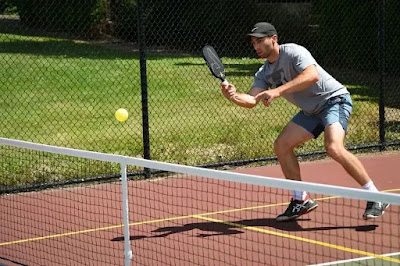How to Play Wheelchair Pickleball - The Rules You Need to Know
Wheelchair pickleball is a sport that anyone can enjoy, even if they use a wheelchair. It is similar to regular pickleball, which is a game that mixes tennis, badminton, and table tennis. The main difference is that some players on the court are in wheelchairs and have some special rules.
 |
| How to Play Wheelchair Pickleball - The Rules You Need to Know |
What are the basic rules of wheelchair pickleball?
Wheelchair pickleball has the same basic rules as regular pickleball for singles or doubles, except for a few adjustments. For example, the rules for serving, avoiding the Non-Volley Zone (also called the Kitchen), making line calls, and avoiding faults are the same for wheelchair pickleball and regular pickleball. However, there are some specific rules for wheelchair pickleball that you need to know:
1. You need more room around the court
The court size is the same for wheelchair pickleball and regular pickleball: 44 feet long by 20 feet wide. However, you need more room around the court to move your wheelchair safely and comfortably. The suggested total playing area for wheelchair pickleball is 74 feet long by 44 feet wide (which is 3,256 square feet), and if you are playing in a stadium court, you need even more room: 80 feet long by 50 feet wide (which is 4,000 square feet). If the court does not have enough space of at least 5 feet on the sides or 8 feet behind the baseline, you can ask for a replay if you could not reach the ball because of the lack of room.
2. Your wheelchair is part of your body
Your wheelchair is counted as part of your body in wheelchair pickleball. This means that all the rules that apply to your body also apply to your wheelchair, except for one rule about the Non-Volley Zone that we will explain later. For example, if the ball hits your wheelchair, you lose the point because it is a fault.
3. You can hit the ball after it bounces twice
In regular pickleball, you can only hit the ball after it bounces once on your side of the court. If it bounces twice, it is a fault and you lose the point. However, in wheelchair pickleball, you have an extra bounce to hit the ball. You can hit the ball after it bounces once or twice on your side of the court, or even if it bounces off the court.
4. Your back wheels must be in the right place when you serve
When you serve in wheelchair pickleball, you can have your front wheels on or over the baseline or inside the court. However, when you hit the ball, your back wheels must be touching the correct serving area. The serving area is either the right or left service box depending on whether you are serving first or second in each game.
5. Non-Volley Zone Faults Are Based on Your Back Wheels
A wheelchair player can have their front wheels in the Non-Volley Zone when hitting a volley. A volley is when you hit the ball before it bounces on your side of the court. However, a wheelchair player cannot have their back wheels in the Non-Volley Zone when hitting a volley. If they do, they have committed a fault and will lose the rally. Also, remember that the double-bounce rule for wheelchair pickleball applies to a ball that lands in the Non-Volley Zone.
6. Singles Pickleball for Skill Levels 3.5 and Below Uses Half of The Court
For singles pickleball with one or more wheelchair players on the court in skill levels 3.5 and below, play will be reduced to half of the court. Players will play the entire rally crosscourt or diagonally. However, for singles pickleball for skill levels 4.0 and above, play will be on the whole court.
If a wheelchair player is playing with or against a standing player, then the rules of pickleball for standing players will apply to them, while the rules of pickleball for wheelchair players will apply to them.
Pickleball is a great game that can be played by both standing players and wheelchair players!





